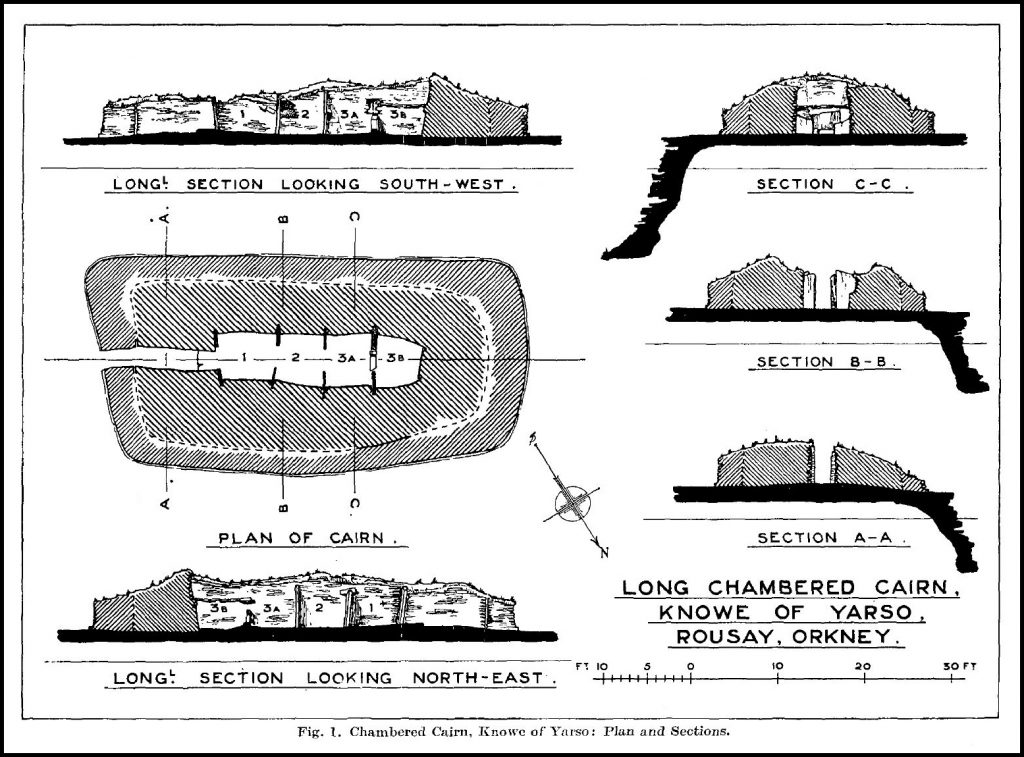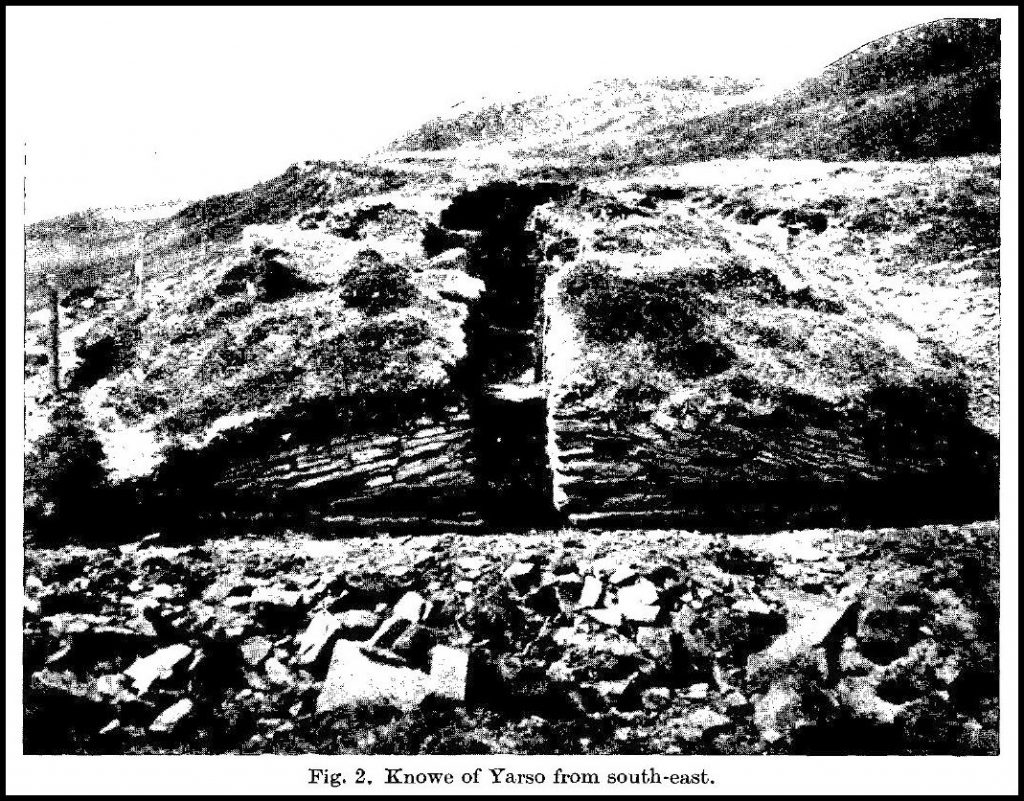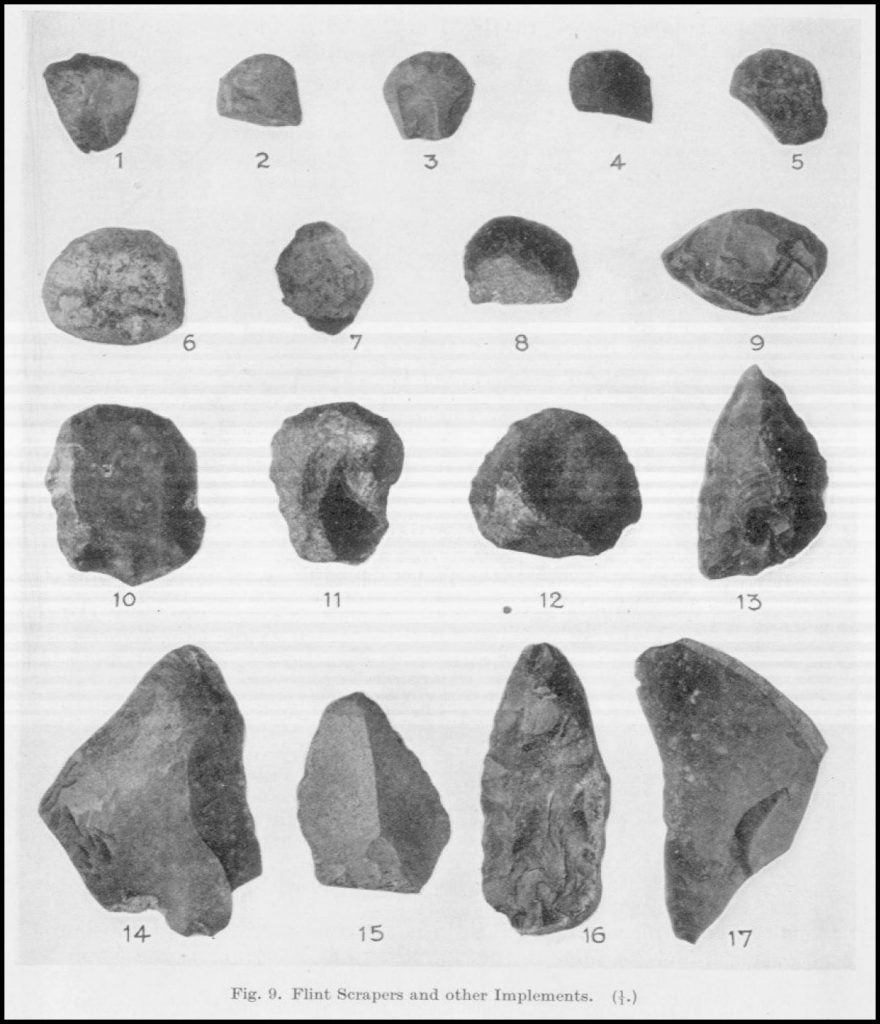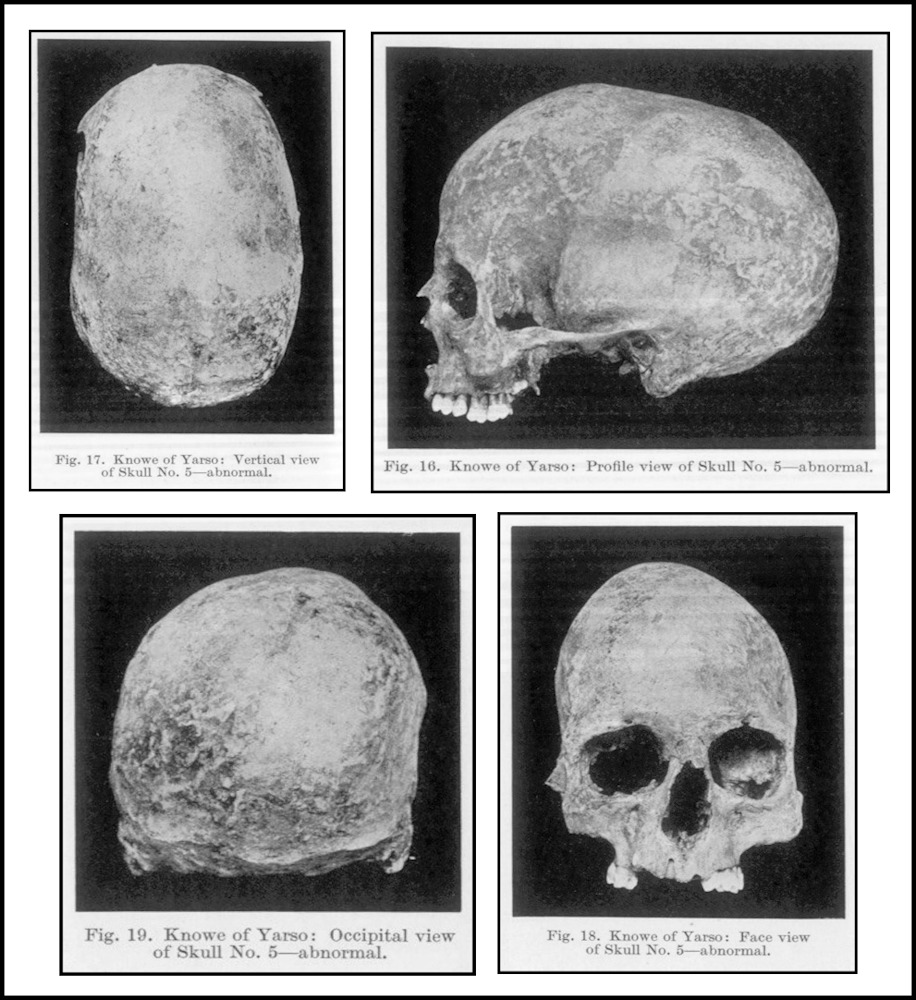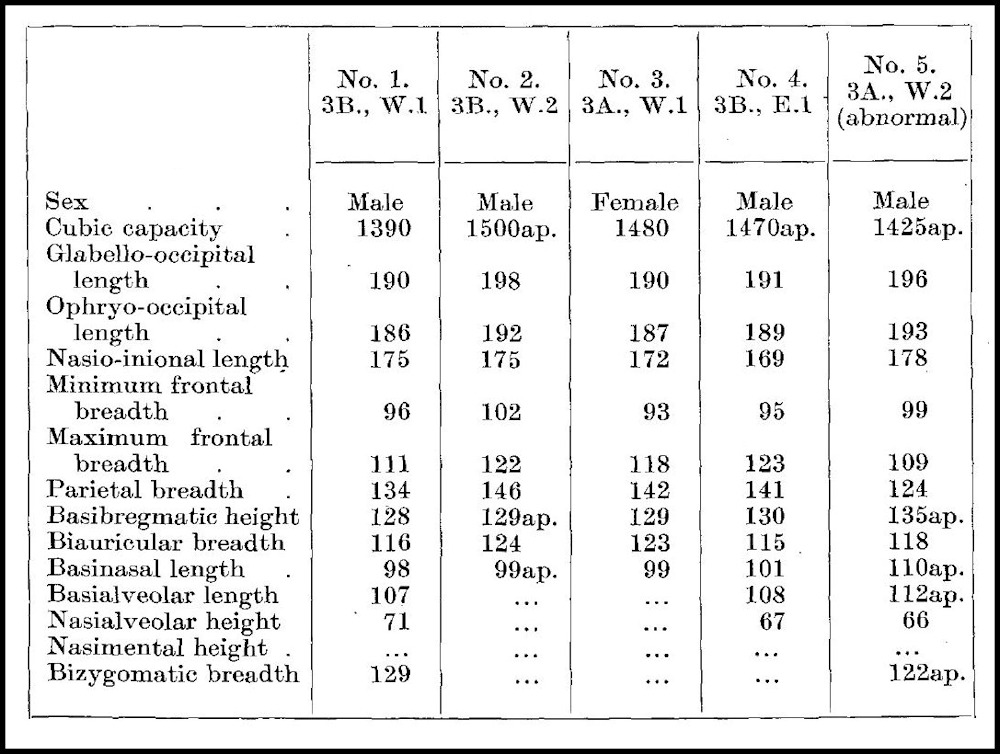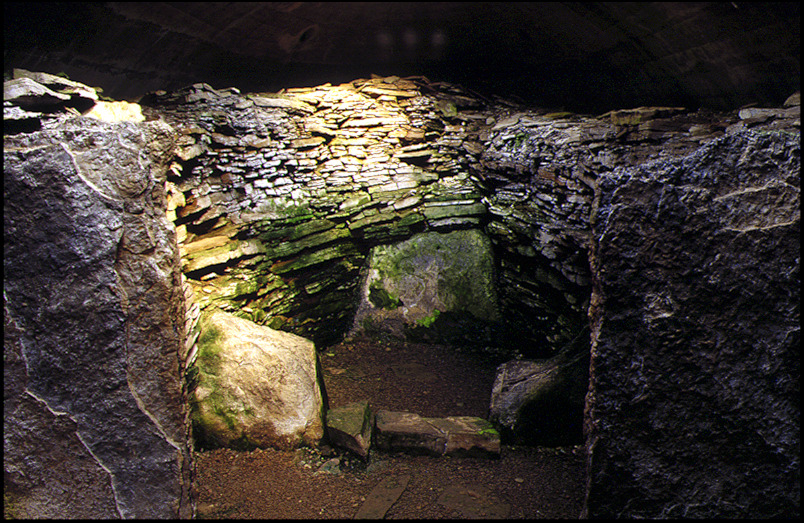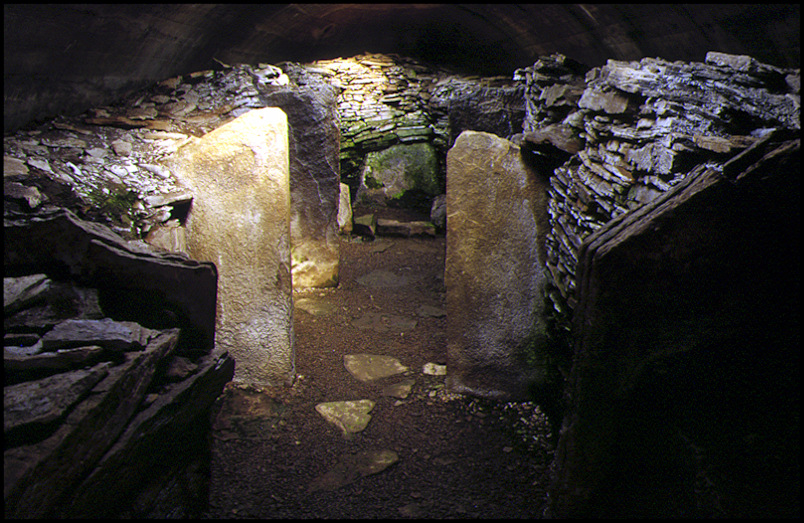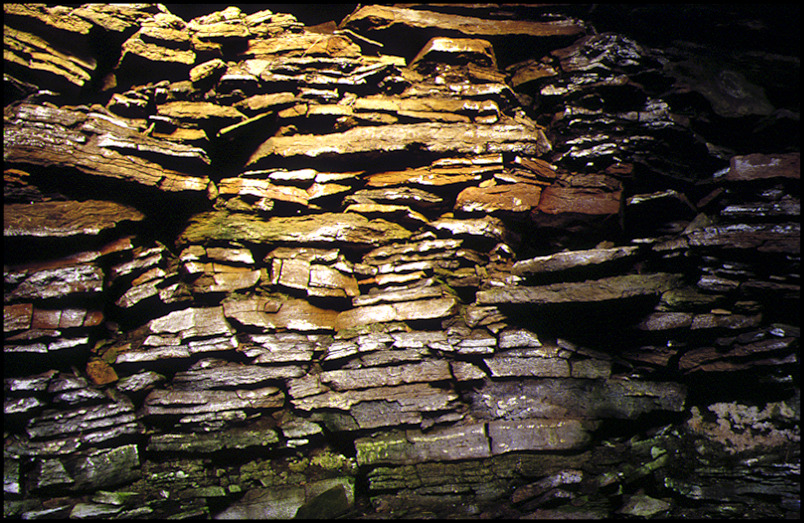A LONG, STALLED CAIRN, THE KNOWE OF YARSO, IN ROUSAY, ORKNEY
by
J. Graham Callander, LL.D., F.S.A.Scot.,
Director of the National Museum of Antiquities,
and Walter G. Grant, F.S.A.Scot.
In many parts of the island of Rousay the land rises from the shore in a series of shelves or flat, narrow plateaux, exposing, in places, a face of much weathered flagstone rock of the Old Red Sandstone formation. On the south-western slopes of Blotchnie Fiold, the highest hill in Rousay, 821 feet high, which lies in the south part of the island overlooking Eynhallow Sound, these shelves are prominent features in the landscape, as will be seen in fig. 2. In the area known as Frotoft, about 500 yards slightly east of north of the standing stone on the roadside at Langstane, and about 480 yards west-north-west of the farm of Mid Crusday, at an elevation of 300 feet above sea-level, was a mound of stones overgrown with heather and grass, known as the Knowe of Yarso, and marked on the 0.S. Map as a broch. However, it was a cairn erected close to the outer margin of a shelf, which is about 50 yards wide at the spot, and is bordered by a rocky escarpment about 30 feet high. As the edge of the rock is jagged, in parts there was only room to pass between it and the cairn, and at no place was the side of the structure more than 12 feet distant from the brink. To the south the monument commands a magnificent view of the island of Mainland and of many others, from the mouth of Eynhallow Sound on the west to the island of Stronsay on the east. Before excavation it was quite evident that this was a stalled, chambered cairn of the same class as the Neolithic cairn at Midhowe, lying about 3 miles to the north-west, described last year in the Proceedings, vol. lxviii. p. 320, because the tops of three pairs of erect slabs set in alignment across the structure, dividing the chamber into three compartments, projected above the debris with which the interior was encumbered. However, it differed from the Midhowe cairn inasmuch as it was shorter and had been destroyed in a different fashion. At Midhowe the roof had collapsed before the structure was despoiled in later times, and even then the stones which had fallen into the chamber had not been removed. At Yarso the superstructure of the monument had been carried away for building purposes, and all the large stones which had fallen into the central cavity had been dragged out, with the result that there was more soil amongst the debris than at Midhowe, and the relic bed on the floor with its contents was much disturbed.
The mound, which was rectangular with rounded ends, measured 62 feet in length, 32 feet in breadth, 6 feet in height at the north-west end, and 4 feet at the south-east, but the cairn proper within the accumulation of soil and debris is 50 feet long and 25 feet 6 inches in greatest breadth. The main axis lies 45° west of north magnetic, approximately north-west by west and south-east by east. The sides are nearly straight, the four corners and the north-west end rounded, and the south-east end, where the entrance is placed, straight.
This cairn bears a striking resemblance to the Midhowe mausoleum both in its internal and external structural features. The chamber in each monument is divided into stall-like compartments by flagstones set on end opposite each other on both sides, only, while there are twelve compartments or cells at Midhowe, there are but three at Yarso (fig. 1 above). In both the inner cell is subdivided, and there are indications that there had been an upper storey at the farther end. It will be remembered that at Midhowe there is a face of walling within the mound, and that the outer wall is built with the stones not placed on the flat, but with their outer edges lying obliquely; the same features with certain modifications are to be seen at Yarso.
The foundation course of the outer wall consists of fair-sized flagstones laid flat, and projecting outwards about 3 inches from the face of the wall so as to form a plinth. At the south-east end of the cairn the stones forming the outer face of the wall on the west side of the entrance slope downwards from right to left (fig. 2); on the east they slant down from left to right, and this formation continues right round the monument until the south-west corner is reached (figs. 2, 3, and 4). The outer face of the wall still maintains a height of 2 feet 9 inches and 3 feet 3 inches on the west and east sides of the entrance, 2 feet 4 inches at the south-east corner, from 3 feet to 3 feet 2 inches along the east side, 1 foot 11 inches at the north-east corner, 2 feet 7 inches at the north-west end, and from 2 feet 6 inches to less than 1 foot along the west side. In places, owing to the face of the wall slipping forward, the plinth is barely visible. It is not known whether the upper part of the outer face may not have been built with the stones laid with a reverse slant and a flat string-course below, as in the Midhowe cairn (fig. 5), but in the latter the top of the string-course is only 2 feet 6 inches above the foundation, while at Yarso the face rises over 3 feet in height without any indication of a change in the style of building, and thus it is quite likely that the upper part of the wall was constructed with the stones slanting in the same direction as the lower.
Near the northern end of the east side a break in the surface of the building has exposed a length of about 8 feet of the face of an inner wall built in the ordinary way, 2 feet 4 inches in from the outer face (figs, 3, 2, and 4, 2). This portion of the inner wall stands 2 feet 2 inches above the remaining part of the outer one, which is about 3 feet high here, thus indicating a surviving height of about 5 feet for the former. The inner wall was not traced farther except at the north-west corner, but it seems practically certain that it extends right round the cairn as its ends are clearly seen on both sides of the entrance passage 3 feet 10 inches from its outer end.
The burial chamber and its entrance passage (figs. 2 and 6) are placed almost in the centre of the cairn, the passage measuring along its medial line 13 feet 2 inches in length and the chamber 24 feet 1 inch. The width of the cells varies from 5 feet 5 inches to 6 feet, and the average distance between the inner ends of the divisional slabs is 2 feet 7 Inches. Both the entrance and the chamber have been rudely paved with flat stones.
The Entrance Passage. – This measures 13 feet 3 inches in length on the west side and 13 feet 1 inch on the east, and its walls still average about 3 feet in height – at the middle of their length they are 6 inches higher. The width is 1 foot 11 inches at the outside, 2 feet 4 inches about half-way along, and 2 feet at the inner end. As no lintels survive the height of the entry is unobtainable, but it must have been no less than 3 feet at any part, and so it would not be necessary to crawl in on the hands and knees as in some of the Caithness cairns where the portal is only 2 feet and 2 feet 6 inches high. It may be mentioned that in the cairn of Maeshowe the entrance at the outside is 4 feet 4 inches in height. There is a sill or step, rising 4 inches in height, 11 feet from the outer end of the passage at Yarso, and the floor of the chamber is continued about this level to the inner end.

The Chamber. – As already stated, the gallery is divided into three compartments or cells by pairs of upright flags built into and projecting from the wall on either side, almost opposite each other (fig. 6). These slabs vary from 2½ inches to 5 inches in thickness. The first pair, which are placed immediately at the inner end of the passage with their inner edges in line with its walls, project 1 foot 10 inches from the wall on the west side of the gallery, and 1 foot 2 inches from that on the east side. They measure 4 feet 1 inch and 4 feet 6 inches in height, their tops being highest in the middle, one being curved and the other ending in an obtuse angle. The next pair, which are set up 7 feet and 6 feet 1 inch farther in, project 1 foot 4 inches and 1 foot 6 inches, and measure 4 feet 9 inches and 4 feet 3 inches in height; their tops are bevelled downwards from the edge nearest the centre of the chamber to the wall. The third pair stand 5 feet 2 inches and 5 feet 9 inches from the last two, and project 1 foot 5 inches and 1 foot 8 inches. They are 5 feet 2 inches and 4 feet 11 inches in height, and the tops are roughly level. The distance between them and the inner end of the gallery is about 10 feet 10 inches. The lower part of the wall at the inner end is formed by a slab set on edge, measuring 3 feet 1 inch in breadth at the bottom, 2 feet 8 inches at the top, and 3 feet 1 inch in height, and the upper part by building about 3 feet 5 inches high, which curves into the side walls (fig. 6). This gives a total height of 6 feet 6 inches for the inner end of the chamber as it now stands. The end slab has been inserted after the side walls had been built as they extend beyond it. The same thing is to be seen in the cairns at Midhowe and Unstan. Along the centre the cells Nos. 1, 2, and 3 measure about 6 feet 6 inches, 5 feet 6 inches, and 10 feet 10 inches in length. Cell No. 3 is subdivided into two parts by low septal slabs and blocks of stone. Two flags project 1 foot 9 inches from the side walls, but their height is only 1 foot 10 inches as their tops have been clured off with stone tools. The space between their inner edges is blocked by two stones 5 inches high. The inner half of this cell seems to have had an upper storey, otherwise it is difficult to explain a scarcement 3 inches wide that runs round the wall at an average height of 3 feet 9 inches above the floor, and a wall-hold projecting 7 inches from the east wall about the same level, above the low divisional slab. A break exactly opposite in the west wall suggests that there had been a corresponding wall-hold there. The width of the chamber here is 5 feet 11 inches, but there would have been no difficulty in getting a lintel to span the vacancy. At the chambered cairn Taiverso Tuick, only about a mile away, there is an upper storey, and it is believed that a similar feature existed in the Midhowe cairn.
In noting the distances that the divisional flagstones project from the wall the measurements stated were all taken on the south side of the stones. If measured on the north side there would have been a difference of from 1 inch to 2 inches but no more, so the side walls are not exactly aligned. This may give an indication as to the method of erecting the cairn. This suggests that, the site having been decided on, the upright divisional flagstones were placed in position before the walls between them were built up.
Relics. – Save for an occasional animal bone no relics were found until the chamber had been cleared out to within 1 foot 9 inches of the floor, after which numerous fragments of human skeletal remains and a large quantity of animal bones were encountered. An exception, however, has to be made in the case of the inner cell, No. 3, where a few pieces of human bones were found about the height of the scarcement, 3 feet 9 inches above the floor. These may have been late intrusions, but we think it more likely that they had been brought up from a lower level when the stones that had fallen into the chamber were being dragged out. Several shards of pottery, a few implements of bone, and a considerable number of tools and chips of flint were also recovered. It was very difficult to detect the last, as from the position of the cairn, on a flat rocky shelf, the seep of water from the higher ground to the north-east had made the relic bed very wet. Indeed, although all the sodden earth was carefully examined, handful by handful, a number of flints were recovered only after the wet soil had been spread out and washed by rain. So much disturbance had taken place while the stones were being dragged out when the upper part of the cairn was being removed that practically all the long bones and many of the human skulls had been smashed and displaced, human and animal bones being mixed up promiscuously. In one place where there were two broken skulls lying near each other, with animal bones between and around them, a deer tooth actually lay within the brain-pan of one. Nowhere was it possible to detect where a single body had been placed, as no limb bones occupied the relative positions of a skeleton either in a crouched or extended position.
Human and animal bones were found in the entrance passage and in each of the three cells, but more than four-fifths of the former and most of the latter came from the inner cell, No. 3. As we have seen, the latter is subdivided into two parts by low divisional stones, so to simplify description these compartments will be referred to as Nos. 3A and 3B, the last being at the inner end. Unless specifically mentioned, the human and animal remains were distributed over the floors of the different cells.
The scanty and much broken remains of one adult were found in the entrance passage, two in cell No. 1 and one in cell No. 2. When cell No. 3 was reached human bones were much more numerous. From the outer half, No. 3A, skeletal remains of seven adults and one adolescent were recovered. Skulls of five adults, three fragmentary and two rather better preserved, were found lying at the foot of the wall on the western side, and the remains of the other three individuals in the middle of the cell. But it was cell No. 3B that yielded most of the osseous remains. No less than seventeen adults were represented by skulls usually very much broken, vertebrae, fragments of eight femurs, other leg bones, and two humeri. Nine of the skulls were placed in juxtaposition along the foot of the western wall, six along the opposite side, and two about 15 inches from it. In no case was the lower jaw present. A very fine skull was found in the south-west corner of the cell, touching the divisional slab, which doubtless accounts for its good state of preservation.
Although some of the skulls arranged along the foot of the wall had suffered from disturbance, it seemed that they had been placed cranium upwards facing the centre of the chamber.
The bones of twenty-nine individuals at least, twenty-eight adults and one under twenty years of age, were identified. Owing to the broken state of the bones the sex was determined in only three cases, two male and one female; other two were doubtfully male.
An occasional fragment of highly calcined bone, probably human, but very small and in a very friable condition, was recovered.
The quantity of animal bones found was considerable, and consisted almost entirely of red-deer, many being of the size of the best animals existing in Scotland to-day. Bones from thirty-six of these animals were identified. Ox and sheep were just represented, and there were a few bones of a good-sized dog. Many limpets were found, and it may be recalled that about three gallons of them were discovered in a heap at the floor level in Midhowe cairn. Fish was represented by wrasse as at Midhowe. The bones were distributed throughout the relic bed of the chamber, but, as already mentioned, were more numerous in the inner half. They were much broken, and included teeth, ribs, and many articular ends and splinters of leg bones. The latter presumably had been deliberately split to get at the marrow. Many of the Yarso animal bones showed distinct marks of scorching and burning, as did a few from Midhowe.
Pottery was extremely scarce, and what we did find seems to have been deposited at a time later than the original burials. Near the top of the relic bed were found a basal fragment of a food-vessel (fig. 7, No. 1) and three small pieces of the wall. These were found quite close to the two skulls in cell No. 3B, inside one of which the deer tooth was lying. The food-vessel was of very dark ware, and was ornamented with vertical, deeply incised zigzag lines. There were also two wall fragments of other two vessels. One, of dark pottery, buff-coloured on the outside, and decorated with an incised zigzag, measuring less than 1 square inch, was so thin as to suggest that the vessel may have been a beaker (fig. 7, No. 2). The other, which was also dark in colour but with a reddish outer skin, measured 2¼ inches by 115/16 inch by ½ an inch. It bore two horizontal lines with short oblique ones above, all slightly incised (fig. 7, No. 3). It is quite impossible to determine accurately what kind of vessel it formed a part. The food-vessel seems to be the first recorded from Orkney, and the same may be said of the beaker if we are correct in our identification.
Implements and small flakes and splinters of flint were quite numerous and there were a few of grey chert; a considerable number were calcined. The implements consisted of two leaf-shaped arrow-heads, measuring 15/16 inch by 9/16 inch and ¾ inch by ½ inch, one barbed and stemmed with one barb broken off, measuring ¾ inch in length, and one very crudely made specimen with the suggestion of a tang and its edges battered, measuring 13/16 inch by 11/16 inch (fig. 8); a knife of red colour nicely worked along one edge, measuring 1⅞ inch in length, and another of grey colour, measuring 2 inches in length (fig. 9, Nos. 16 and 17); one object which has been identified as a burin d’angle or graver, measuring 1½ inch by 1⅛ inch (fig. 10); forty-six scrapers; and sixteen worked flints, a total of sixty-nine objects. The barbed arrow-head, three scrapers, four knives, and a worked flint came from the relic bed in cell No. 1. Two scrapers were found 2 feet above the floor of cell No. 2, and two knives and twenty scrapers in the bottom layer. At the latter level in cell No. 3A there were recovered a leaf-shaped arrow-head, a knife, and two scrapers, and in cell No. 3B three scrapers. The remaining implements were found in the sludge which covered the floor of the chamber. A selection of scrapers and other implements is shown in fig. 9. In addition the following flakes and splinters were found: twenty-three from cell No. 1, fifteen from cell No. 2, fourteen from cell No. 3A, and nineteen from cell No. 3B, all from the relic bed. So far as we know the burin is the first recorded from Scotland, with the exception of some Tardenoisian micro-burins.
Most of the scrapers are of small size and often of irregular shape. They measure from 7/16 inch by 17/32 inch to 1 13/16 inch by 1 inch in size. The flint is typical of what is found in Orkney, some being cherty and most of poor quality. The predominating colour is from light grey to dark and there are a few yellow. The collection again demonstrates how fully the meagre supply of this much sought after material was utilised in Orkney. It may be recalled that geologists consider that this flint was brought up from the bed of the North Sea, from the south-east, by ice.
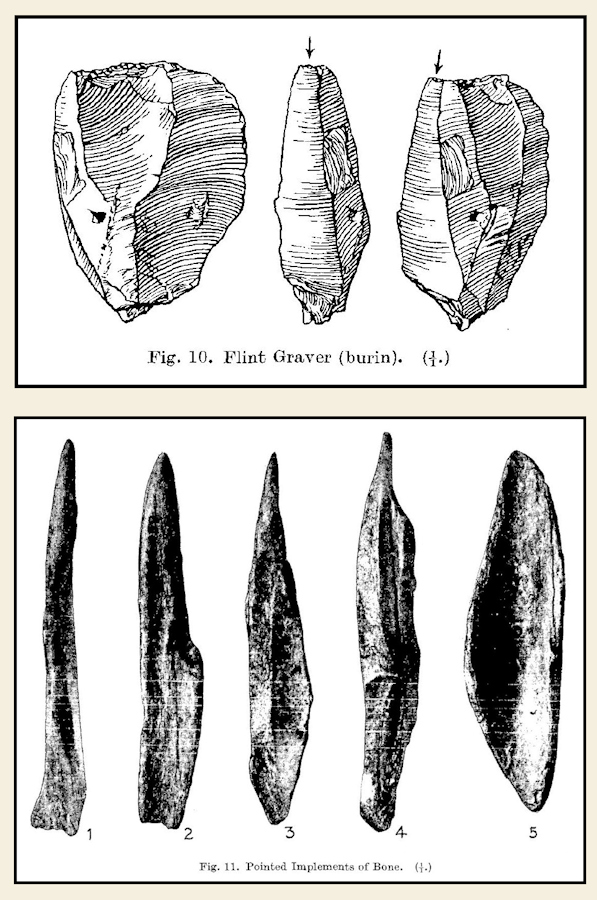
One tine of the red deer, with the point sharpened, measuring 3 15/16 inches in length, and five pointed implements made out of splintered ox bones, were found ‘in the lowest level in cells Nos. 2 and 3. Two other splinters with spatulate ends were also recovered, one about half-way up cell No. 2 (fig. 11, No. 5). With the exception of one of the pointed tools all were more or less decayed, the surface cracked and scaling off in places; it is difficult to say whether the spatulate objects are really artifacts. The five undoubted implements consist of a pin, measuring 2 inches in length, two bluntly pointed instruments, measuring 3¾ inches and 3 9/16 inches in length (fig. 11, Nos. 1 and 2), a sharply pointed object, measuring 3½ inches in, length (fig. 11, No. 3), and one with a narrow point squared at the end measuring 3 13/16 inches in length (fig. 11, No. 4). The last resembles some implements dating to Palaeolithic times found in France, which are recognised by archaeologists in that country as having been used for flaking flint. On one side of the point of the Yarso example is a carefully made hollow, into which the thumb fits comfortably, and it may well have been used for pressing off small flakes of flint.
In describing the stalled cairn at Midhowe last session we expressed the opinion that to a certain extent it had been used as an ossuary (Proceedings, vol. lxviii. pp. 334 and 335), because in addition to skeletal remains from bodies which had been placed in a crouching position, and perhaps in some cases in a sitting position, being found, there were deposits of bones from dismembered skeletons or parts of skeletons. In the Knowe of Yarso by far the greater number of skulls were arranged along the base of the walls of the two sections of the inner cell, No. 3, and so far as we could see they showed no individual relationship to the other bones. Of course, the layer containing the remains, except in the parts that lay close to the walls, was much disturbed and mixed up, presumably when the cairn was plundered for building stone. Thus it would seem that this monument should be considered an ossuary rather than a burial vault. At Midhowe the whole twenty-five individuals had been placed in the eight inner cells and none in the four which had to be traversed to reach the first deposit. At Yarso, of the twenty-nine individuals buried, twenty-five were found in the two sections of the inner cell, No. 3, seventeen in the inner half and eight in the outer. Presumably, the first burials would take place in the inner section of the inner cell, and when that was fully occupied those following would be deposited in the adjoining one. Our suggestion that the reason why no human remains were found in the four outer cells at Midhowe was that some of the bodies had been placed there until the tissues had decayed, and the bones could be removed to the inner chambers. This may quite well hold good for Yarso, as the remains of only four persons were found in the entrance passage and cells Nos. 1 and 2.
We have seen that many of the flint implements and some of the animal bones found were calcined. There are also distinct indications of fires burning within all the cells of the chamber, and on both sides. Many of the stones in the walls are reddened and cracked by fire, and bear traces of soot, from a height of 1 foot 6 inches to 3 feet above the floor. At the same time, quite a lot of pieces of charred wood and ashes were observed in the deposits on the floor. No signs of fires were seen outside the entrance.
One of the skulls from cell No. 3B, that noted as No. 4 in Professor Low’s report, shows evidence of having been in contact with fire. This would seem to show that the fires had been kindled within the chamber after some of the skulls had been deposited.
While the two cairns were extraordinarily rich in skeletal remains, twenty-five individuals at Midhowe and twenty-nine at Yarso, the amount of pottery recovered was most disappointing. Fragments of seven Neolithic vessels, mostly of the Unstan type, were found at Midhowe, but not a single shard of this period was got at Yarso. This is the more surprising when we recall the great collection of pottery found in the Unstan cairn on the adjoining island of Mainland, and the considerable quantity in the Taiverso Tuick cairn in the near vicinity of Yarso. As for the flint implements recovered, the position is reversed. Midhowe produced only one, Unstan eight, and Yarso sixty-nine.
Seeing that no Neolithic pottery was found at Yarso, but fragments of a food-vessel and possibly part of a beaker were discovered, it might be argued that the cairn should be considered as belonging to the Bronze Age. But the forms of the few skulls surviving in a measurable condition indicate the earlier period. They clearly show Neolithic characteristics, and not those of the Bronze Age people. Further, Yarso has the chamber divided into stalls like the cairns at Unstan, Midhowe, and Taiverso Tuick, all of which yielded Neolithic pottery, and, like the last two, seems to have had an upper storey at the inner end. As for the presence of Bronze Age pottery, we have evidence elsewhere in Scotland of late intrusions into Neolithic cairns, as witness the beaker pottery from the cairns at Lower Dounreay; Caithness, Clettraval, North Uist; and Rudh’ an Dunain, Skye; and the flat discoidal beads of shale at Yarrows, Caithness.
We should again like to express our great indebtedness to Mr James K. Yorston and his son James for the careful and intelligent way in which they assisted us to excavate the cairn, and to Professor Low and Miss Platt for their reports on the osseous remains.
Mr Grant has handed over the monument to H.M. Office of Works for preservation, and has given the skeletal remains to the Anatomical Department of Aberdeen University. He has also most kindly presented the artifacts found to our National Museum.
REPORT ON THE ANIMAL BONES
by
Margery I. Platt, M.Sc., Royal Scottish Museum, Edinburgh.
Numerous animal remains associated with Neolithic human burials were found at Yarso during excavations there by Dr J. Graham Callander and Mr Walter G. Grant in the summer of 1934. These relics are fragmentary in the extreme, yet nevertheless are of great interest in that they provide evidence of the wild life on the island in early prehistoric times. Abundant as these remains are, there is not one bone complete. In the case of the limb bones it seems quite clear from the longitudinally split fragments that they have been broken purposely for extraction of the marrow. Under these circumstances, too, it is difficult to deduce the actual size of the animals, but some idea of this may be assumed from the relative size of the articulating processes which have been preserved. In addition, it may be recorded at the outset that the use of fire is clearly evinced throughout every part of the excavation, from the many bones which have been merely charred or further calcined. The various species are dealt with below under headings representing the level at which they were found.
Entrance Passage – relic bed on floor. – The shells of limpets (Patella malgata) occurred here having both low and high cones, indicative of their being gathered from both exposed and sheltered parts of the beach. The greater part of the remains were composed of skeletal fragments of the Red Deer (Cervus elaphus). They represented two adults and one very young fawn. Both the flesh and marrow of these, together with the soft parts of the limpets, no doubt provided food for these early peoples.
No. 1 Chamber – relic bed on floor all over chamber. – In this section were the remains of three red deer, fully adult, as indicated by the lower jaws in which the molar teeth were well worn. There were also a few limb bones of very immature animals. The only antlers represented were two small tines. Lastly, there was the almost complete tibia of a dog, probably of similar height to our collie of the present day. One limpet shell only was present.
No. 2 or Middle Chamber – relic bed on floor all over chamber. – Bones of the red deer again predominated as in Chamber No. 1. The relics indicated the presence of two adults, as large as any maximum modern representative of this species, though not so massive as those whose remains have been recovered from prehistoric deposits in Scotland. For instance, a deer’s skeleton found in the peat moss in East Lothian, now preserved in this museum, was one and a quarter times as large again as these Orkney deer. Further, a young specimen was present in whose jaw the milk molar had not been shed. One small tine occurred here too. Though of no prehistoric value, it is interesting to note that some bones had been gnawed by a small rodent, possibly the Orkney vole. A few limpet shells also were found.
No. 3 or Inner Chamber. – Top of relic bed 1 foot 6 inches to 2 feet above floor all over the chamber. – A great collection of red deer bones was present at this level, six animals being represented. Most individual bones of the skeleton were found, but only one small tine. There were the remains of two sheep, one approaching maturity, the other a very small lamb, and limpet shells also occurred.
From 1 foot to 1 foot 6 inches above floor all over the chamber. – In this section there were more bones of red deer than in any other part. Ten adults were represented, though not all of equal size. Four were as large as to-day’s maximum, whilst the others were smaller in differing degrees. The well-preserved teeth indicate a difference of age in the various adults. Some were old, with molars well worn down, whilst others were not so old and have much higher crowns. One decidedly immature beast was present, having the last milk molar still present and lacking the last permanent molar. Limpet shells were in abundance from several localities. Three ribs of sheep occurring here are probably accidental. About 1 foot above the floor were found pharyngeal bones of the wrasse, Labrus maculatus.
Lowest level. – Bones of red deer were most numerous. Lower jaws, odd teeth, limb bones, and ribs, etc. were in a fragmentary state, four adults being represented in the west half of 3B, and two in the east half. Only one rib of a sheep was present, as also the humerus of a dog derived from an animal of similar size to that indicated by the tibia found in Chamber No. 1. Limpet shells gathered in both exposed and quiet localities were plentiful. Two wing bones of small birds whose actual species have not been determined were also found. There were marks of gnawing on some of the bones.
Bones of three red deer and a fragment of a large antler came from the west half of 3A. Two of the tibia are judged to be of the same size as those of a maximum-sized stag of the present day, the third being rather smaller. The remains of three more deer came from the East half of this section, as also a single piece of a rib of an ox, 12 cm. in length, and the fourth metatarsal (left side) of a dog of a large size, corresponding with the other canine remains recorded above. The ox bone was the only authentic fragment of this species, and one may not lay too much significance upon the presence of this animal.
The chief interest in the facts recorded above lies in the ample remains of red deer. on the island of Rousay during a Neolithic period.
Although it is generally recognised that red deer existed in the Orkneys in prehistoric times, its occurrence in Rousay (N. of Pomona) is unrecorded for such a date. Definite dating is always difficult, and placed localities of Pleistocene or post “Pleistocene” period cited in a recent publication – Reynolds, A Monograph on the Pleistocene Mammalia, vol. Iii. part iv. pp. 4-9 (The Paloeontographical Society) – are both situated on the island of Mainland, otherwise Pomona. The prehistoric range of red deer given in a map in The Influence of Man on the Animal Life in Scotland (Ritchie, 1920) is seen only in a restricted part of Pomona and islands to the east of this, and consequently does not include Rousay. Hence these facts extend the range of the red deer in the Orkneys generally at a time when the presence of man had not materially affected its numbers, directly or indirectly. As stated previously, the red deer no doubt was the chief source of food of these early inhabitants, together with the shellfish represented here by limpets. There is little evidence of domestic stock. Most of the sheep bones occurred in the upper layers, and jaw bones only at the top level, where bones of red deer were correspondingly sparse. Also the presence of ox is extremely doubtful, since only one fragmentary rib was found, and it may have accidentally fallen from surface soils.
Altogether three fragmentary bones of a dog occurred in differing situations, although their size indicates they may have all belonged to the same animal. In the absence of jaws or a more complete skeleton, one may regard these remains as accidental or intrusive. Further, the dimensions are not consistent with those of a dog from such an early period.
In conclusion I wish to record my thanks to Mr Grant and Dr Callander, who have kindly put the material at my disposal
REPORT ON THE HUMAN SKELETAL REMAINS.
by Professor Alex. Low, M.A., M.D., F.S.A.Scot.
Dr Callander and Mr Walter G. Grant have given an account of the position in which the human remains described in this report were found. The remains represent at least twenty-nine individuals, all adult except for one young individual perhaps about eighteen years of age. As is mostly the case in Neolithic interments the bones are poorly preserved. The broken nature and irregular position of the skeletal remains suggest that there probably had been some disturbance of the original interments. In all, only five skulls and four leg bones are approximately complete.
One cranium, except for the mandible, is complete and excellently preserved, and fortunately other four with some reconstruction are in fairly good condition and admit of measurements being recorded.
List of Skulls.
No. 1. (Cell 3B, west side of inner compartment.) Complete cranium; male, between 30 and 40 years.
No. 2. (Cell 3B, west side of inner compartment.) Cranium, face absent; male, about 40 years.
No. 3. (Cell 3A, west side of outer compartment.) Cranium, face absent; female, about 45 years.
No. 4. (Cell 33, east side of inner compartment.) Cranium, fairly complete; male, about 25 years.
No. 5. (Cell 3A, west side of outer compartment.) Complete cranium but abnormal; male, probably early twenties.
Skull No. 1 (figs. 12 to 15) is complete except for the mandible, and is that of a male. The teeth are in very good condition and have all been present at death, but the two upper central incisors are now missing. The teeth do not show any trace of disease and the amount of attrition of the crowns is very slight, not more than would be expected in an individual in the late twenties. On the other hand the sutures on the inner aspect of the cranium are all closed; on the outer aspect the whole of the sagittal suture, and the coronal and lambdoid sutures except at their lower parts are obliterated. The condition of the sutures would indicate an individual of at least forty years of age.
The cranium is elongated and ovoid with a relative breadth of 70.5 per cent – dolichocephalic. The profile view shows a long skull of medium height with glabella and superciliary arches moderately developed; upper part of forehead rather full; occipital squama projecting well beyond the inion. The upper face is relatively long, the orbits and nasal aperture from their indices are just to be reckoned narrow; the upper jaw is prognathous, this is largely due to subnasal prognathism but is partly accounted for by the rather short basinasal length. The occipital view (fig. 15) shows well the pentagonal outline, parietal eminences placed high up, and the sides flattened. The cranial capacity of 1390 c.c. of mustard seed is rather under the average.
Skull No. 2 is represented by the calvaria, and is that of a male, the condition of the sutures indicating an individual about forty. While this is a larger and more massive calvaria, it has much the same characters as the previous skull; thus it is elongated and ovoid with projecting occipital squama. The cubic capacity is approximately 1500 c.c. and the length-breadth index 73.7 – dolichocephalic.
Skull No. 3 is a calvaria with the facial skeleton missing, except for the two nasal bones. It is that of an individual probably about forty-five years of age; the sex is somewhat doubtful, but on the whole the characters are those of a rather muscular female. The upper orbital margins are thin and sharp, the glabella and superciliary arches faintly marked, and the forehead high and well arched; there is flatness of the vertex, prominence of the parietal eminences and the side walls of the skull approach the vertical. The skull is relatively somewhat wider with a cephalic index of 74.7 – just in the dolichocephalic group.
Skull No. 4. This cranium, apart from lower jaw, is sufficiently intact to allow of a fairly complete series of measurements being obtained. The skull is that of a young individual, and sex characters, though not so marked, are those indicating a male. The basilar suture is closed, but all the other sutures of the cranium are open both ectocranially and endocranially; the teeth in the upper jaw have all been present at death, but now only five remain; these are in very good condition, the amount of attrition being slight, and further, in the same compartment and similarly stained as the skull, there was a male left hip-bone, in which the secondary epiphysis has only partly fused along the crest; there is a probability that the skull and the hip-bone belonged to the same individual, a young man about 25 years. In its cranial features this skull is very similar to the others; the glabella and superciliary arches are of medium development, upper part of forehead prominent, occipital squama projecting; face of medium height with upper jaw projecting – prognathous; orbits and nose narrow.
Skull No. 5 is abnormal and of remarkable shape and will be described separately.
Unfortunately, the other bones of the skeletons are very fragmentary. Several separate vertebrae show marked evidences of rheumatism. Of the many limb bones, only one right femur and three separate tibiae are complete. The maximum length of the femur is approximately 430 mm., which gives a calculated stature of about 5 feet 4 inches. The shafts of three other femora are intact and the diameters of the upper third of the shaft in four specimens measure 28 by 36; 26 by 33; 26 by 36; 28 by 40; the proportion of the antero-posterior to the transverse diameter varying from 70 to 78.7 per cent. – a degree of platymeria usually present in femora of the Neolithic period. In the middle of the shaft the antero-posterior diameter was the greater in four male femora, and also in two female femora; the linea aspera in the four male femora was well developed.
The total length of each of the three entire male tibiae is 330 mm., 331 mm., and 346 mm. respectively; calculating by Pearson’s formula gives a stature of approximately 5 feet 3 inches, practically the same as that obtained from length of femur; the two short male tibia are right and left and seem to be a pair. In addition to these three entire tibiae there are the shafts of seven others with the upper and lower ends deficient. Of the seven tibiae two are rather slightly built and probably female, the other five are stouter bones and probably male. The tibiae are flattened from side to side, being platycnemic; the diameters at the level of the nutrient foramen of the eight bones apparently males, give a mean index of 66.5 and of the two female 72.2.
The limb bones on the whole are such as would have belonged to individuals of average muscular development; further, they are relatively short, and so far as can be calculated from the measurements obtainable the men were about 5 feet 4 inches in stature.
The skulls are very similar to those recovered from the Midhowe stalled cairn, and indicate a people with elongated heads, with forehead rather prominent, brow-ridges moderately developed, nose narrow and orbits not wide, and face prognathous.
Skull No. 5 consists of the calvaria with the facial portion fairly complete, but the lower jaw is missing. The skull presents unusual features in that it shows very marked asymmetry associated with premature closure of the sutures. The skull is probably that of a young male, but no trace of suture is to be seen on the calvaria, the synostosis being so complete that there is no indication of the separate bones. The teeth are irregular; there is no trace of the presence of the lateral incisors; the left canine is present and erupted, but the right while present in the jaw is unerupted; the two right bicuspids are also unerupted, while the two left are erupted; the first and second molars are well developed and present on both sides; the third molars are unerupted; the crowns of the erupted teeth show little attrition. The irregularity in suture closure and in eruption of teeth make it difficult to assign an age for the skull, but it might be that of a young man in the early twenties.
The dimensions and features of the skull can be learned from the illustrations (figs. 16 to 19). The asymmetry is noticeable in the vertex view, the long axis passing through the right frontal eminence which projects in front of its fellow. There is asymmetry of the base of the skull, the transverse level of the left external ear being in advance of the right. There is also asymmetry of the face and palate. The cranium is very narrow from side to side, and viewed from above is boat-shaped, cranial index 63.3 – ultradolichocephalic; further, there is marked heightening especially of the upper part of the frontal region in the facial view, producing the appearance of steeple-skull. A factor in the production of this abnormal skull form, has been an arrest of growth with premature closure of the cranial sutures.
In fig. 20 are shown face views of skulls Nos. 1, 4, and 5, and vertical views of skulls Nos. 2 and 3.
We are greatly indebted to Walter G. Grant, Esq., F.S.A.Scot., of Trumland, Rousay, who has presented these Neolithic skeletal remains for preservation in the Anatomy Museum, University of Aberdeen.
TABLE 1
Measurements in mm. of Skulls from a Long, Stalled Cairn, the Knowe of Yarso, Rousay, Orkney.
Extracted from the Proceedings of the Society of Antiquaries of Scotland, Volume 69, pp. 325-351, March 11th 1935.
Available in the Orkney Room at Orkney Library & Archive
